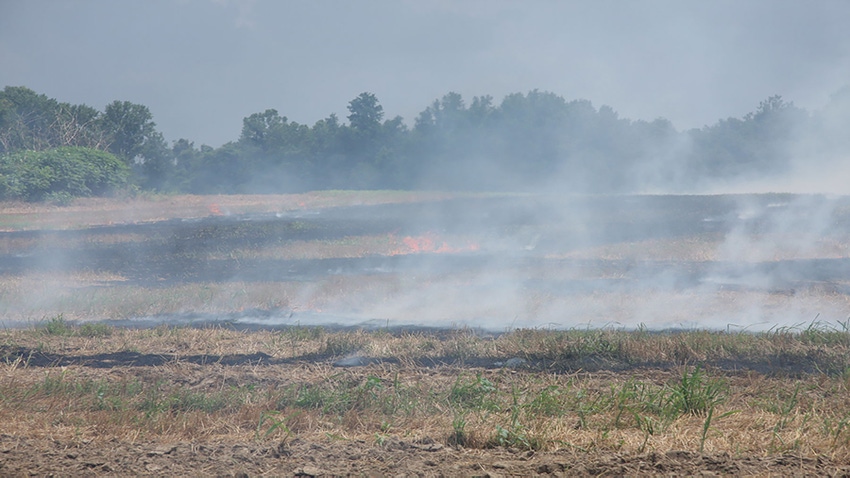
As a safety precaution, prescribed burns of cropland, grassland, and forests should be reported to the appropriate dispatch center or fire department. In Arkansas, producers and landowners can now voluntarily report prescribed fires directly to the Arkansas Department of Agriculture from their desktop or mobile device with a new app called FireSMART.
Robert Murphy, emergency services director for the Division of Forestry at the Arkansas Department of Agriculture, participated in the Innovation Panel at the Arkansas Rice Annual Meeting on Jan. 26 in Stuttgart. He discussed the development and features of the app.
Murphy said this effort came about after the department began collecting data on the number of agricultural burns across the state. Results revealed that a great number of burns were going unreported, with only 193 total burns voluntarily reported in Arkansas from 2018 through 2022.
With smoke management issues becoming more prevalent in communities across the state, the department took a proactive approach to ease the process of planning and voluntary reporting.
The app was developed in collaboration with the Arkansas Division of Environmental Quality, and it was built with producers and landowners in mind as the end users. A panel, which included agricultural producers, collaborated on the development. The app was launched in the fall of 2022, and Murphy said prescribed burns have already been submitted through the new reporting platform.
Using FireSMART to Report Prescribed Burns
In the past, prescribed fires were voluntarily reported through a phone call to the department’s dispatch center. From there, dispatch would run the calculations to determine if the burn was recommended based on voluntary smoke management guidelines.
The web-based app seamlessly takes the place of this process. This tool is mobile friendly and easy to download to the home screen of your device. Users can access the FireSMART app through the Arkansas Department of Agriculture website, or directly by going to Arkfiresmart.com.
Murphy said that reporting a burn through the app takes just a few minutes, and the process gets easier with use.
On the main screen of the app, users can select the button to “submit a burn” and then choose the location of the prescribed fire on an interactive map. Once the location is selected, the app provides users with area-specific information to determine if burning conditions are favorable that day.
Real-time weather conditions include wind direction, wind speed, and humidity. The app also gives the category day on a scale from 1 to 5 for the location. FireSMART users are then prompted to enter the type of field crop or forestry, fuel loading, and total acreage for the burn.
The app automatically calculates the total tonnage and generates a smoke screen on the interactive map to show the direction the smoke will go. Furthermore, it pinpoints any nearby smoke-sensitive areas such as city limits, highways, hospitals, schools, and urban centers.
Based on the recommended guidelines and available airshed allotment, users can choose whether to burn or adjust the parameters of their planned burn.
Murphy said, “The app tells you whether the fire will exceed the recommended guidelines, and it also takes account of any other burns submitted in the same airshed that day.”
The final step of the process requires contact information and the start and end date of the planned fire. Murphy noted this step is a safety precaution, and site-specific information is not retained in the database.
“Contact information and specific location of the burn is only kept in the database for 24 hours,” he said. “That way if the dispatch center gets a call, we can contact the person doing the burn.”
After that timeframe, the database is purged. Murphy noted that the only data retained from the report is the county, number of acres, and what was burned.
Being Proactive to Prevent Future Regulation
The app does more than just tell producers whether it is safe to burn. It serves as a collaborative communication tool, and stored data provides proof that Arkansas farmers and foresters are taking proactive safety precautions when planning prescribed fires.
Ryan Sullivan, farmer from Mississippi County, served as the moderator for the Innovation Panel. He emphasized that prescribed burning is a beneficial and economical management tool often misunderstood by many outside the agricultural community.
“As producers we need to take steps to show that we are being proactive and avoid any future regulations. The most influential thing we can do as farmers is to educate the public about the practical reasons we need to burn and show them that we are taking the necessary precautions,” Sullivan said.
Murphy agreed that it is far better for the agricultural community to carry out best management practices on a voluntary basis rather than through regulation.
In a press release, Arkansas Secretary of Agriculture Wes Ward said, “The Arkansas Department of Agriculture encourages everyone within the agriculture industry to follow voluntary smoke management guidelines. The FireSMART app gives them a quick and easy tool to continue to be good neighbors to all Arkansans.”
Online resources, guidelines, and an outreach tool kit for voluntary smoke management can be found on the Arkansas Department of Agriculture website.
About the Author(s)
You May Also Like






